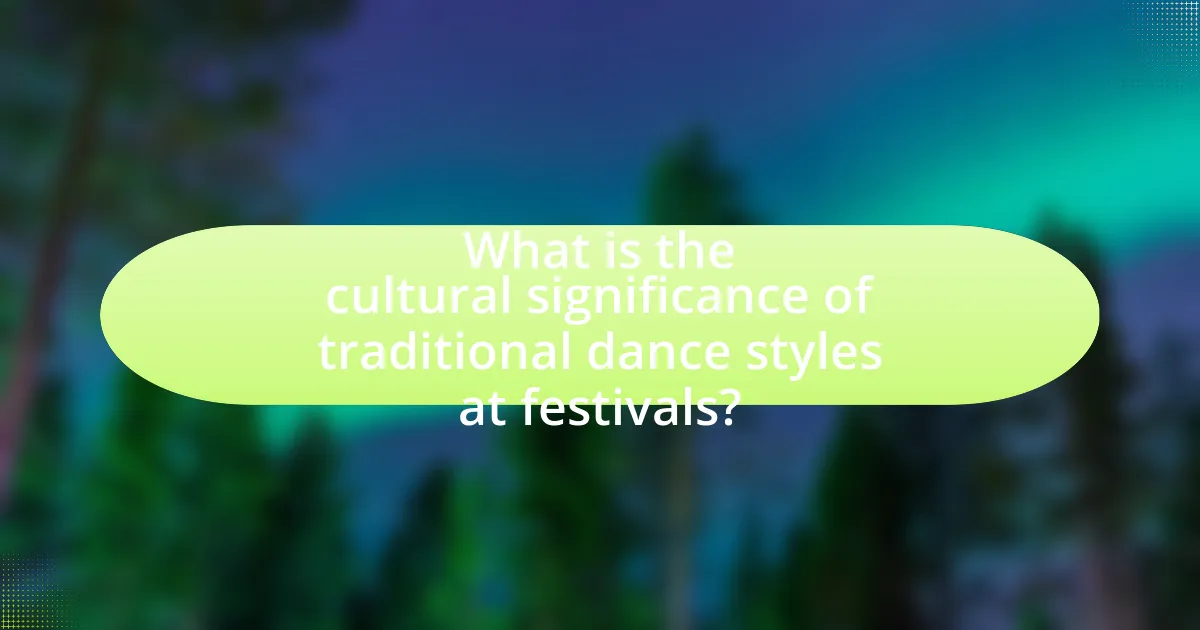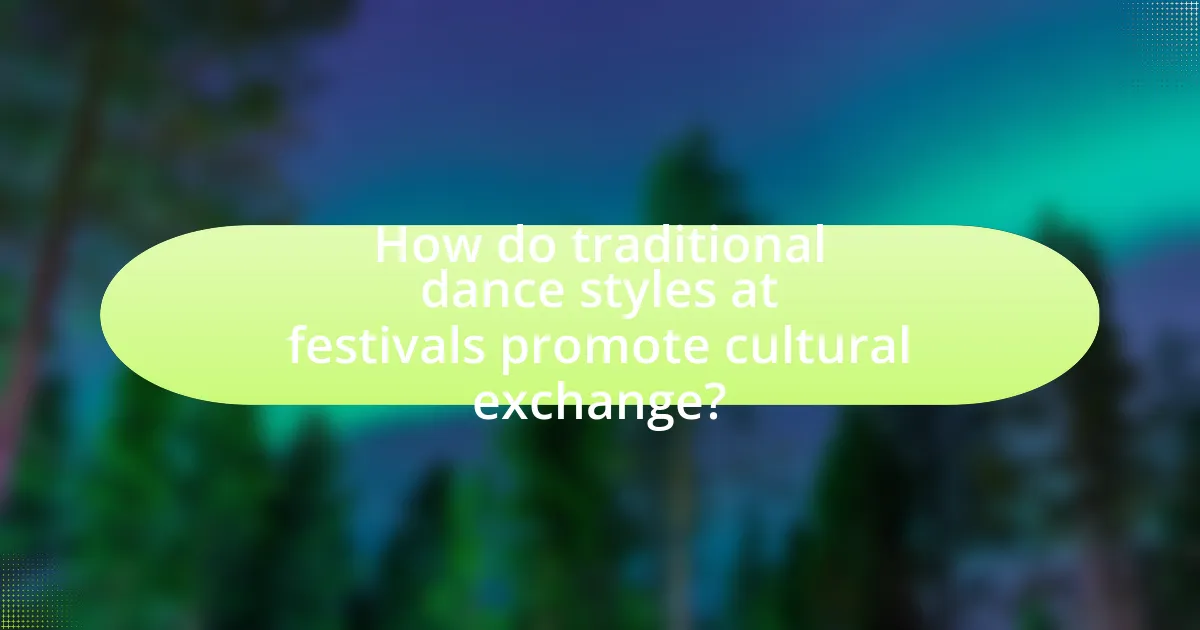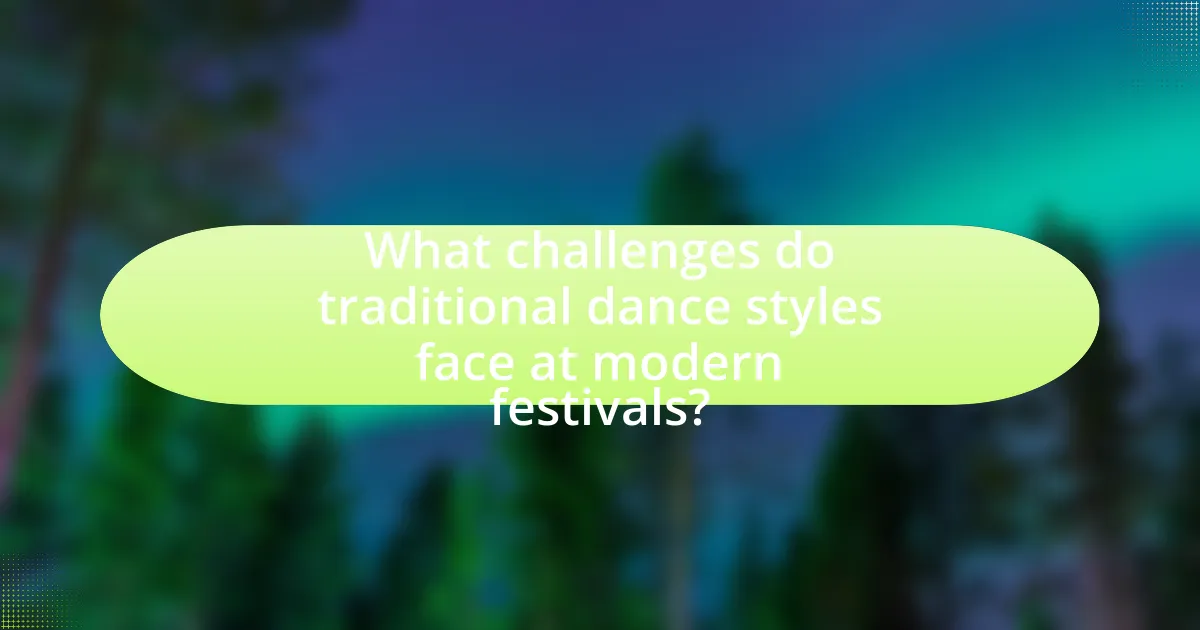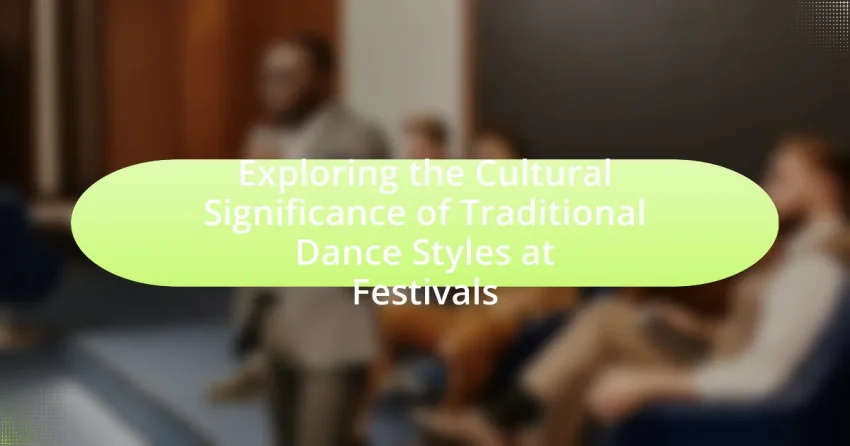The article explores the cultural significance of traditional dance styles at festivals, highlighting their role in preserving cultural identity and fostering community engagement. It examines how these dances reflect cultural values through specific movements, costumes, and music, while also discussing the importance of festivals in transmitting dance traditions across generations. Additionally, the article addresses the challenges faced by traditional dance forms in modern contexts, including globalization and commercialization, and emphasizes the need for education and community involvement in safeguarding these cultural practices. Overall, it underscores the vital connection between traditional dance and cultural heritage at festivals.

What is the cultural significance of traditional dance styles at festivals?
Traditional dance styles at festivals hold significant cultural importance as they serve as a means of preserving and expressing cultural identity. These dances often reflect the history, values, and beliefs of a community, allowing participants and audiences to connect with their heritage. For instance, the Powwow dances of Native American tribes not only celebrate tribal traditions but also foster a sense of unity and continuity among members. Additionally, traditional dances can promote social cohesion and community pride, as seen in the vibrant performances during the Carnival in Brazil, which highlight Afro-Brazilian culture and history. Thus, traditional dance styles at festivals are vital for cultural transmission and community engagement.
How do traditional dance styles reflect cultural identity?
Traditional dance styles reflect cultural identity by embodying the values, beliefs, and historical narratives of a community. These dances often incorporate specific movements, music, and costumes that are unique to a culture, serving as a medium for storytelling and the preservation of traditions. For example, the Hula dance of Hawaii conveys the history and mythology of the islands through its gestures and chants, while the Flamenco of Spain expresses the emotional depth and cultural struggles of the Andalusian people. Such dances are not only performed during festivals but also play a crucial role in maintaining cultural continuity and fostering a sense of belonging among community members.
What elements of traditional dance convey cultural values?
Elements of traditional dance that convey cultural values include movements, costumes, music, and storytelling. Movements often reflect social norms, historical events, or rituals significant to a culture, such as the intricate footwork in Irish dance symbolizing community and heritage. Costumes typically represent cultural identity, using colors and patterns that have specific meanings, as seen in the vibrant attire of Native American dances that signify tribal affiliation. Music accompanying traditional dances often incorporates instruments and rhythms unique to a culture, reinforcing its distinctiveness, like the use of drums in African dance that connects participants to their ancestry. Additionally, storytelling through dance conveys moral lessons and cultural narratives, exemplified by the use of dance in Balinese performances to depict religious tales. These elements collectively serve to preserve and communicate the values, beliefs, and history of a culture.
How do costumes and music enhance the cultural narrative in dance?
Costumes and music significantly enhance the cultural narrative in dance by visually and audibly representing the traditions, values, and stories of a culture. Costumes often incorporate specific colors, patterns, and materials that reflect cultural heritage, while music provides the rhythmic and melodic context that drives the dance movements. For instance, in traditional Indian dance forms like Bharatanatyam, intricate costumes and classical music convey themes from mythology and spirituality, reinforcing the narrative being expressed through movement. This synergy between costumes and music not only captivates the audience but also deepens their understanding of the cultural significance behind the performance, as evidenced by studies showing that visual and auditory elements in dance can evoke emotional and cognitive responses related to cultural identity.
Why are festivals important for preserving traditional dance?
Festivals are crucial for preserving traditional dance because they provide a platform for cultural expression and community engagement. During festivals, traditional dances are performed in their authentic forms, allowing for the transmission of techniques, stories, and cultural values from one generation to the next. This practice is supported by research indicating that festivals serve as living archives of cultural heritage, where participants and audiences alike engage with and reinforce their cultural identities. For instance, the National Endowment for the Arts highlights that community festivals often include workshops and performances that educate attendees about the historical significance and techniques of traditional dances, ensuring their continuity and relevance in contemporary society.
What role do festivals play in community engagement and participation?
Festivals play a crucial role in fostering community engagement and participation by bringing individuals together to celebrate shared cultural values and traditions. These events create opportunities for social interaction, allowing community members to connect, collaborate, and strengthen their relationships. For instance, research indicates that festivals can enhance social cohesion, as seen in studies where communities reported increased feelings of belonging and unity following local celebrations. Additionally, festivals often involve participatory activities, such as traditional dance performances, which encourage active involvement and cultural expression among attendees. This engagement not only promotes cultural heritage but also empowers individuals to contribute to the community’s identity and continuity.
How do festivals contribute to the transmission of dance traditions across generations?
Festivals contribute to the transmission of dance traditions across generations by providing a communal space where these dances are performed, learned, and celebrated. During festivals, older generations actively teach younger participants the steps, rhythms, and cultural significance of traditional dances, ensuring that these practices are not only preserved but also adapted to contemporary contexts. For instance, events like the National Folk Festival in Australia showcase various indigenous and folk dance forms, allowing for intergenerational interaction and learning. This direct engagement fosters a sense of identity and continuity, as evidenced by studies showing that participation in cultural festivals enhances the transmission of traditional knowledge and practices among community members.
What are the different types of traditional dance styles featured at festivals?
Traditional dance styles featured at festivals include folk dances, ceremonial dances, and regional dances. Folk dances, such as the Irish jig or the Spanish flamenco, often reflect the cultural heritage and community spirit of a region. Ceremonial dances, like the Native American powwow dances or African tribal dances, are performed during rituals and celebrations, emphasizing spiritual significance. Regional dances, such as the Bavarian Schuhplattler or the Indian Bharatanatyam, showcase the unique characteristics and traditions of specific areas. These dance styles not only entertain but also serve to preserve cultural identity and foster community cohesion at festivals.
How do regional variations influence traditional dance styles?
Regional variations significantly influence traditional dance styles by shaping their movements, music, and costumes based on local customs and cultural heritage. For instance, the Flamenco dance from Spain incorporates elements of Andalusian culture, characterized by its passionate movements and guitar music, while the Bharatanatyam from India reflects the religious and historical narratives of South Indian temples through intricate footwork and expressive gestures. These differences are rooted in the unique social, historical, and environmental contexts of each region, which dictate the themes and techniques of the dances. The diversity in traditional dance styles showcases the rich tapestry of cultural identities, as evidenced by the distinct variations found in folk dances across different countries, such as the Irish jig and the Scottish reel, each representing their respective cultural backgrounds and traditions.
What are some examples of traditional dances from various cultures?
Examples of traditional dances from various cultures include the Flamenco from Spain, the Hula from Hawaii, the Kathak from India, and the Irish Dance from Ireland. Flamenco, characterized by its passionate movements and intricate footwork, has roots in Andalusian culture and is often performed at festivals. Hula, a dance form that tells stories through movement and chant, is integral to Hawaiian culture and is showcased during celebrations like the Merrie Monarch Festival. Kathak, one of the eight classical dance forms of India, combines storytelling with intricate footwork and is often performed during cultural festivals. Irish Dance, known for its rapid leg and foot movements while keeping the upper body stationary, is prominently featured in events like the All-Ireland Dance Championships. Each of these dances reflects the unique cultural heritage and traditions of their respective regions.

How do traditional dance styles at festivals promote cultural exchange?
Traditional dance styles at festivals promote cultural exchange by providing a platform for diverse communities to share their heritage and artistic expressions. These performances allow participants and audiences to engage with different cultural narratives, fostering understanding and appreciation. For instance, festivals often feature dance styles from various regions, enabling attendees to experience the rhythms, costumes, and stories unique to each culture. This interaction not only enhances social cohesion but also encourages dialogue about cultural identities, as seen in events like the Edinburgh Festival Fringe, which showcases international dance forms and attracts performers from around the globe.
What opportunities do festivals provide for cultural interaction?
Festivals provide significant opportunities for cultural interaction by bringing together diverse communities to share traditions, art forms, and social practices. These events facilitate direct engagement among participants through performances, workshops, and communal activities, allowing individuals to experience and appreciate different cultural expressions. For instance, festivals often feature traditional dance styles that represent various ethnic backgrounds, enabling attendees to learn about the historical and social contexts of these dances. Research indicates that such interactions can enhance cultural understanding and foster social cohesion, as evidenced by studies showing increased intercultural dialogue and reduced prejudice in festival settings.
How do traditional dances facilitate dialogue between different cultures?
Traditional dances facilitate dialogue between different cultures by serving as a medium for expression and understanding. These dances often incorporate elements from various cultural backgrounds, allowing participants and audiences to engage with diverse traditions and narratives. For instance, festivals that showcase traditional dances, such as the International Folklore Festival, promote cultural exchange by inviting performers from multiple countries to share their unique dance forms, fostering appreciation and respect among different cultural groups. This interaction not only enhances social cohesion but also encourages the sharing of stories, values, and histories, thereby enriching the cultural tapestry of the community involved.
What impact does cultural exchange have on the evolution of dance styles?
Cultural exchange significantly influences the evolution of dance styles by facilitating the blending of diverse movements, techniques, and traditions. This interaction leads to the creation of hybrid dance forms, as seen in the emergence of styles like salsa, which combines elements from African, Caribbean, and European dance traditions. Historical examples include the influence of African rhythms on jazz dance in the United States, showcasing how cultural interactions can reshape and innovate dance practices. Additionally, festivals serve as platforms for this exchange, allowing dancers from various backgrounds to share and adapt their styles, further enriching the global dance landscape.
How can traditional dance styles foster inclusivity at festivals?
Traditional dance styles can foster inclusivity at festivals by encouraging participation from diverse cultural backgrounds and promoting shared experiences. These dance forms often serve as a bridge between different communities, allowing individuals to express their heritage while inviting others to join in. For instance, festivals that feature traditional dances from various cultures create an environment where attendees can learn about and appreciate different customs, thereby enhancing social cohesion. Research indicates that events showcasing cultural diversity, such as the National Folk Festival in Australia, lead to increased community engagement and understanding among participants, highlighting the role of traditional dance in fostering inclusivity.
What initiatives encourage participation from diverse communities in dance?
Initiatives that encourage participation from diverse communities in dance include community outreach programs, cultural exchange workshops, and inclusive dance festivals. Community outreach programs often collaborate with local organizations to provide free or low-cost dance classes that reflect the cultural backgrounds of participants, fostering engagement and representation. Cultural exchange workshops allow dancers from different backgrounds to share their traditional styles, promoting understanding and appreciation among diverse groups. Inclusive dance festivals celebrate various cultural dance forms, providing a platform for performers from different communities to showcase their heritage, thereby enhancing visibility and participation. These initiatives have been shown to increase community involvement and cultural exchange, as evidenced by studies indicating that festivals featuring diverse dance styles attract larger audiences and foster community cohesion.
How do festivals create spaces for marginalized dance forms?
Festivals create spaces for marginalized dance forms by providing platforms for diverse cultural expressions and fostering inclusivity. These events often feature performances that highlight underrepresented dance styles, allowing artists from marginalized communities to showcase their heritage and skills. For instance, festivals like the Edinburgh Festival Fringe have dedicated slots for traditional and folk dances, which may not receive attention in mainstream venues. This visibility not only elevates the status of these dance forms but also encourages cultural exchange and appreciation among audiences, thereby validating and preserving these art forms within the broader cultural landscape.

What challenges do traditional dance styles face at modern festivals?
Traditional dance styles face several challenges at modern festivals, primarily including cultural dilution, competition with contemporary performances, and logistical constraints. Cultural dilution occurs when traditional dances are adapted or altered to appeal to broader audiences, often losing their original significance and context. Competition with contemporary performances can overshadow traditional styles, as modern dance forms often attract more attention and resources, leading to reduced visibility for traditional acts. Logistical constraints, such as limited performance time and space, can hinder the ability of traditional dancers to showcase their full repertoire, further diminishing their impact at these events.
How is globalization affecting traditional dance practices?
Globalization is significantly impacting traditional dance practices by facilitating the exchange of cultural elements, leading to both fusion and dilution of original forms. As cultures interact more frequently through technology and travel, traditional dances often incorporate new styles, music, and movements, which can enhance their appeal but may also compromise their authenticity. For instance, the rise of global dance competitions and festivals has introduced traditional dancers to diverse influences, resulting in hybrid forms that blend local traditions with global trends. This phenomenon can be observed in events like the World Dance Alliance, where traditional dances are showcased alongside contemporary styles, reflecting a shift in audience expectations and participation.
What are the risks of cultural appropriation in dance at festivals?
Cultural appropriation in dance at festivals poses significant risks, including the commodification of cultural expressions and the erasure of their historical context. When individuals or groups adopt dance styles from cultures without understanding or respecting their origins, it can lead to a superficial representation that undermines the cultural significance and meaning behind those dances. For instance, the appropriation of Indigenous dance forms by non-Indigenous performers often strips away the spiritual and communal aspects that are integral to those traditions. This not only disrespects the originating culture but can also perpetuate stereotypes and reinforce power imbalances. Furthermore, the lack of proper acknowledgment and compensation for the original creators can result in economic disadvantages for marginalized communities, as their cultural expressions are exploited for profit without their consent.
How do commercialization and tourism impact the authenticity of traditional dances?
Commercialization and tourism significantly impact the authenticity of traditional dances by often prioritizing entertainment value over cultural integrity. As traditional dances are adapted for tourist consumption, elements may be altered or simplified to meet audience expectations, leading to a dilution of their original meanings and practices. For instance, in Bali, Indonesia, the traditional Kecak dance has been modified to cater to tourists, resulting in performances that emphasize spectacle rather than cultural storytelling. This shift can undermine the educational and cultural significance of the dance, as the original context and rituals associated with it may be lost.
What strategies can be implemented to preserve traditional dance styles?
To preserve traditional dance styles, communities can implement strategies such as documentation, education, and performance opportunities. Documentation involves recording dance forms through video, notation, and written descriptions, ensuring that techniques and cultural contexts are captured for future generations. Education can be facilitated through workshops and classes that teach traditional dances to younger generations, fostering an appreciation and understanding of their cultural significance. Performance opportunities at festivals and cultural events allow traditional dances to be showcased, promoting visibility and encouraging participation. These strategies are supported by research indicating that active engagement and representation in cultural practices are essential for their survival and evolution.
How can education and workshops support the preservation of dance traditions?
Education and workshops can significantly support the preservation of dance traditions by providing structured learning environments where participants can acquire and practice traditional dance forms. These educational initiatives facilitate the transmission of cultural knowledge and techniques from experienced practitioners to new generations, ensuring that specific styles and their historical contexts are maintained. For instance, workshops often include not only dance instruction but also discussions about the cultural significance and history of the dances, which reinforces the understanding and appreciation of these traditions. Research indicates that community-based dance programs have successfully revitalized interest in traditional dance forms, as seen in studies conducted by the National Endowment for the Arts, which highlight the role of educational outreach in cultural preservation.
What role do local communities play in safeguarding their dance heritage?
Local communities play a crucial role in safeguarding their dance heritage by actively participating in the preservation, transmission, and revitalization of traditional dance forms. These communities engage in practices such as organizing festivals, workshops, and performances that celebrate their unique dance styles, ensuring that knowledge and skills are passed down through generations. For instance, in many cultures, elders teach younger members the traditional dances, fostering a sense of identity and continuity. Additionally, local communities often document their dance heritage through recordings and written materials, which serve as valuable resources for future generations. This active involvement not only helps maintain the cultural significance of traditional dance but also strengthens community bonds and promotes cultural pride.
What are some best practices for participating in traditional dance at festivals?
To effectively participate in traditional dance at festivals, individuals should prioritize understanding the cultural context and significance of the dance. Engaging with local dancers or instructors can provide insights into the history and meaning behind the movements, enhancing the overall experience. Additionally, practicing the specific steps and rhythms beforehand ensures better integration into group performances, as many traditional dances rely on synchronized movements. Wearing appropriate attire that reflects the cultural heritage of the dance not only shows respect but also enhances the visual impact of the performance. Lastly, being open to feedback from experienced dancers fosters a collaborative spirit and improves individual skills, contributing to the authenticity of the dance experience.
How can festival-goers respectfully engage with traditional dance styles?
Festival-goers can respectfully engage with traditional dance styles by observing and understanding the cultural context and significance behind the dances. This involves researching the history, meanings, and customs associated with the dance forms before participating. For instance, many traditional dances are rooted in specific cultural rituals or celebrations, and recognizing this context fosters respect. Additionally, festival-goers should seek permission from the dancers or cultural representatives before joining in, as this demonstrates acknowledgment of the dance’s cultural importance. Engaging with local communities and attending workshops can also enhance understanding and appreciation, ensuring that participation is both respectful and informed.
What tips can enhance the experience of watching or participating in traditional dances?
To enhance the experience of watching or participating in traditional dances, individuals should engage actively by learning about the cultural context and history behind the dance. Understanding the origins and significance of the dance style fosters a deeper appreciation and connection to the performance. For instance, knowing that many traditional dances are tied to specific rituals or celebrations can enrich the viewing experience. Additionally, participating in workshops or classes prior to attending a festival allows individuals to practice the movements, making the experience more immersive. Research indicates that active participation can lead to greater enjoyment and cultural understanding, as seen in studies on community engagement in cultural events.
